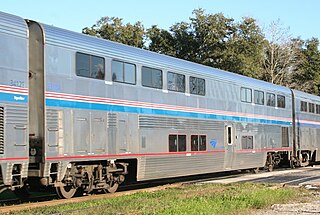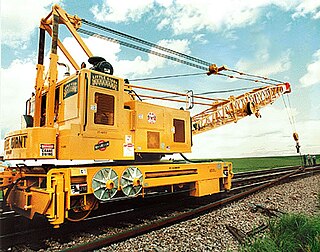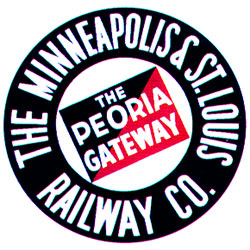
A railcar, in British English and Australian English, is a self-propelled railway vehicle designed to transport passengers. The term "railcar" is usually used in reference to a train consisting of a single coach, with a driver's cab at one or both ends. Some railway companies, such as the Great Western, termed such vehicles "railmotors".
A classification yard or marshalling yard is a railway yard found at some freight train stations, used to separate railway cars onto one of several tracks. First the cars are taken to a track, sometimes called a lead or a drill. From there the cars are sent through a series of switches called a ladder onto the classification tracks. Larger yards tend to put the lead on an artificially built hill called a hump to use the force of gravity to propel the cars through the ladder.

A switcher or shunter is a small railroad locomotive intended not for moving trains over long distances but rather for assembling trains ready for a road locomotive to take over, disassembling a train that has been brought in, and generally moving railroad cars around – a process usually known as switching (USA) or shunting (UK). They do this in classification yards. Switchers may also make short transfer runs and even be the only motive power on branch lines and switching and terminal railroads. The term can also be used to describe the workers operating these engines or engaged in directing shunting operations.

The bilevel car or double-decker train is a type of rail car that has two levels of passenger accommodation, as opposed to one, increasing passenger capacity. In some countries such vehicles are commonly referred to as dostos, derived from the German Doppelstockwagen.

Intermodal freight transport involves the transportation of freight in an intermodal container or vehicle, using multiple modes of transportation, without any handling of the freight itself when changing modes. The method reduces cargo handling, and so improves security, reduces damage and loss, and allows freight to be transported faster. Reduced costs over road trucking is the key benefit for inter-continental use. This may be offset by reduced timings for road transport over shorter distances.

A railway has two major components: the rolling stock and the infrastructure.
Cross-docking is a practice in logistics of unloading materials from an incoming semi-trailer truck or railroad car and loading these materials directly into outbound trucks, trailers, or rail cars, with little or no storage in between. This may be done to change the type of conveyance, to sort material intended for different destinations, or to combine material from different origins into transport vehicles with the same or similar destinations.

A ferry slip is a specialized docking facility that receives a ferryboat or train ferry. A similar structure called a barge slip receives a barge or car float that is used to carry wheeled vehicles across a body of water.

A passenger car is a piece of railway rolling stock that is designed to carry passengers. The term passenger car can also be associated with a sleeping car, baggage, dining, railway post office and prisoner transport cars.

A siding, in rail terminology, is a low-speed track section distinct from a running line or through route such as a main line or branch line or spur. It may connect to through track or to other sidings at either end. Sidings often have lighter rails, meant for lower speed or less heavy traffic, and few, if any, signals. Sidings connected at both ends to a running line are commonly known as loops; those not so connected may be referred to as single-ended or dead-end sidings, or stubs.

A railroad crane is a type of crane used on a railroad for one of three primary purposes: freight handling in goods yards, permanent way (PW) maintenance, and accident recovery work. Although the design differs according to the type of work, the basic configuration is similar in all cases: a rotating crane body is mounted on a sturdy chassis fitted with flanged wheels. The body supports the jib and provides all the lifting and operating mechanisms; on larger cranes, an operator's cabin is usually provided. The chassis is fitted with buffing (UK) and/or coupling gear to allow the crane to be moved by a locomotive, although many are also self-propelled to allow limited movement about a work site.
The Raritan River Rail Road was a twelve-mile (19 km) short-line railroad in Middlesex County, New Jersey U.S., Founded in 1888, it was based in South Amboy, from which it ran west as far as New Brunswick. It served both passengers and freight in its heyday and operated profitably throughout much of its existence. The Raritan River was absorbed into Conrail in 1980, becoming a branch line of Conrail's system.
Railway companies can interact with and control others in many ways. These relationships can be complicated by bankruptcies.

The Minneapolis and St. Louis Railway (M&StL) was an American Class I railroad that built and operated lines radiating south and west from Minneapolis, Minnesota for 90 years from 1870 to 1960.

The Wiregrass Central Railroad is a shortline railroad operating 19.5 miles (31.4 km) of track from a CSX Transportation connection at Waterford, near Newton, to Enterprise, Alabama via the south side of Fort Rucker. The company was initially a subsidiary of Gulf and Ohio Railways and began operations in 1987 following the purchase of the Enterprise Subdivision branch line of CSX Transportation.
Essex Terminal Railway is a Canadian shortline terminal railroad, running from the City of Windsor, Ontario through La Salle, to the Town of Amherstburg, Ontario, for a distance of approximately 21 miles (34 km). The ETR has direct connections to Canadian Pacific Railway, and Canadian National Railway. The railway is owned by Essex Morterm Holdings.

A private railroad car, private railway coach, private car or private varnish is a railroad passenger car which was either originally built or later converted for service as a business car for private individuals. A private car could be added to the make-up of a train or pulled by a private locomotive, providing splendid upholstered privacy for its passengers. They were used by railroad officials and dignitaries as business cars, and wealthy individuals for travel and entertainment, especially in the United States. They were sometimes used by politicians in "whistle stop campaigns". Pay cars with less opulent sleeping and dining facilities were used by a paymaster and assistants to transport and disburse cash wages to railway employees in remote locations without banking facilities.
The Fairhaven Branch Railroad was a short-line railroad in Massachusetts. It ran from West Wareham on the Cape Cod main line of the Old Colony Railroad, southwest to Fairhaven, a town across the Acushnet River from New Bedford.
Detroit Terminal Railroad Company was incorporated in the State of Michigan, United States of America, on December 7, 1905 to own railroad track forming a semi-circle around the City of Detroit. It existed as a railroad until it was merged into its parent company, Consolidated Rail Corp., on May 31, 1984.










